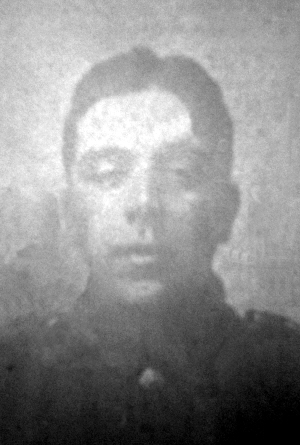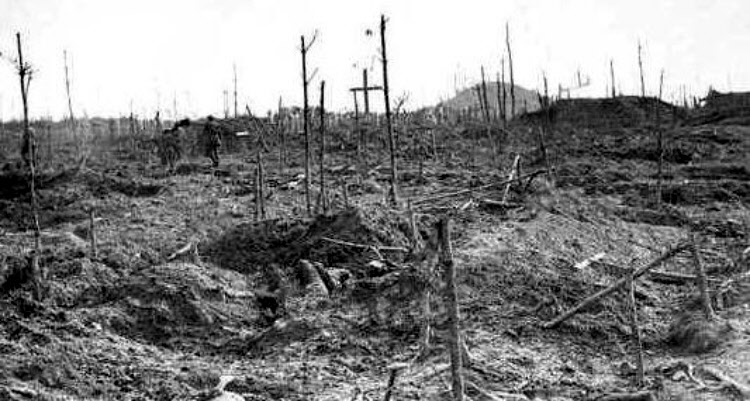
35354, King’s Own Yorkshire Light Infantry, 8th Battalion
Bernard Richmond was born in Ossett on the 4th April 1889 and baptised at South Ossett Christ Church on the 5th January 1890. He was the youngest child of four children born to Allan Richmond and his wife, Rachel (nee Philip), who married in early 1878. Allan was born in Lincolnshire, but Rachel and the children were all born in Ossett.
In 1891 and 1901 Allan Richmond, working as an overlooker in a rag warehouse, wife Rachel and their four children were living in Ossett at Field Head and latterly at Jubb’s Yard. By 1911, Allan and Rachel had moved to Healey Road, Ossett where Allan was now a rag merchant working on his own account. There were two children in the household, including Bernard, aged 22, who was a manager of a rag shop.
On the 6th July 1915 Bernard Richmond married Florence Garbett at Castleford Parish Church. A daughter, Mary Richmond, was born in late 1915 and then a son, Bernard A. Richmond, was born in early 1917. Bernard’s widow Florence re-married to a man called Horace Bray in Castleford in 1921 and the couple went on to settle there.
Bernard Richmond’s army service record has not survived, but it is known that he enlisted at Dewsbury and joined the 8th Battalion of the King’s Own Yorkshire Light Infantry with service no. 35354. Private Richmond was killed in action on the 29th September 1917. Bernard’s elder brother, James Richmond, also served in the Great War and lost his life on the 4th December 1917, some ten weeks after Bernard was killed in action.
Bernard Richmond was posthumously awarded the British and Victory medals, but not the 1914/15 Star, indicating that he did not serve overseas prior to the 31st December 1915.
The 8th Battalion, Kings Own Yorkshire Light Infantry was raised at Pontefract in September 1914 as part of Kitchener’s Third New Army and joined 70th Brigade, 23rd Division. They undertook training in England at Pontefract, Frensham, Aldershot, Hythe and Bordon, before proceeding to France. They landed at Boulogne in August 1915. They transferred to with 70th Brigade to 8th Division on the 18th of October 1915, in an exchange with 24th Brigade allowing the inexperienced troops to learn from those who had battle experience, returning to their original divisions in June 1916. The 23rd Division were at Bomy beginning a period of intensive training for the Battles of the Somme. They were in action in The Battle of Albert including the capture of Contalmaison, The Battles of Bazentin Ridge, Pozieres, Flers-Courcelette, Morval and The Battle of Le Transloy including the capture of Le Sars.
In 1917 they fought in The Battle of Messines, The Battles of the Menin Road, Polygon Wood and the The First and Second Battles of Passchendaele. In November 1917 the Division moved to Italy concentrating between Mantua and Marcaria before taking over the front line at the Montello on the 4th of December.
In 1918 they were in action during the fighting on the Asiago Plateau and the Battle of Vittorio Veneto, including the passage of the Piave and the Monticano. At the Italian Armistice at 3pm on the 4th of November, the 23rd were midway between the Rivers Livenza and Meduna, east of Sacile. They moved to billets west of Treviso and demobilisation took place in January and February 1919.
Private Bernard Richmond was killed in action on the 29th September 1917 during the Battle of Polygon Wood, which was part of the Third Battle of Ypres. 70th Brigade, which included 8th Battalion, KOYLI, was responsible for the line just to the north of the Menin Road. Polygon Wood is situated on a ridge four miles from Ypres and was an important strategic point. It’s capture from enemy forces was a major victory, though short lived in the Battle of Passchendaele. Private Richmond’s battalion had moved up to the front line on the 24th September in preparation for the start of the action, which was planned for the 26th September.
The “Ossett Observer” 1 had this obituary for Private Bernard Richmond:
“Ossett Soldier Killed – Yesterday (Friday) morning the sad news was received of the death of Private Bernard Richmond (28), of the K.O.Y.L.I., a married man whose wife and child reside at Elder Lea, The Green, Ossett, and whose father is Mr. Allan Richmond, rag merchant, of Prospect-road. The deceased, who previous to the war was employed by his father, joined the army in June last year, and went out to the front the following September. In the heavy fighting of last April he was wounded in the head while discharging the duties of stretcher-bearer, and had to be in hospital some time. Recently his relatives heard from him to the effect that he had returned to the fighting area and had had a spell in the trenches. In his last letter he said that he had been expecting a leave home, but had to go back to the trenches. The next news, received yesterday morning, was that he had met his death on the battlefield.
Lieutenant J.H. Baker, in a letter to the deceased’s widow, says: It gives me deep sorrow to have to inform you of the death of your husband, Private B. Richmond, which occurred last night instantaneously, caused by a shell. He had done fine work during the day as a stretcher-bearer, and his death was a blow to all of us. Much more so, however, you will feel the great loss, and I trust that you will find some consolation in the fact that he fell while doing his duty. Trust in the Almighty, and you will find solace to heal the wound that your loved one’s death has caused. I trust that you will find some light through the dark cloud, and believe that God’s work will be done.”

Above: Polygon Wood on September 28th 1917 during the battle where Private Bernard Richmond lost his life.
Private Bernard Richmond, aged 28 years, son of Allan and Rachel Richmond, of 25, Prospect Road, Ossett and husband of Florence Bray (formerly Richmond), of 63, Westfield, Cutsyke, Castleford, died on the 29th September 1917. He is remembered on Panel 108 to 111 at the Tyne Cot Memorial, 2 Zonnebeke, West-Vlandaaren, Belgium. The Tyne Cot Memorial to the Missing forms the north-eastern boundary of Tyne Cot Cemetery, which is located 9 kilometres north east of Ieper town centre, on the Tynecotstraat, a road leading from the Zonnebeekseweg (N332). The names of those from United Kingdom units are inscribed on Panels arranged by Regiment under their respective Ranks.
The Tyne Cot Memorial is one of four memorials to the missing in Belgian Flanders which cover the area known as the Ypres Salient. Broadly speaking, the Salient stretched from Langemarck in the north to the northern edge in Ploegsteert Wood in the south, but it varied in area and shape throughout the war.
The Salient was formed during the First Battle of Ypres in October and November 1914, when a small British Expeditionary Force succeeded in securing the town before the onset of winter, pushing the German forces back to the Passchendaele Ridge. The Second Battle of Ypres began in April 1915 when the Germans released poison gas into the Allied lines north of Ypres. This was the first time gas had been used by either side and the violence of the attack forced an Allied withdrawal and a shortening of the line of defence.
There was little more significant activity on this front until 1917, when in the Third Battle of Ypres an offensive was mounted by Commonwealth forces to divert German attention from a weakened French front further south. The initial attempt in June to dislodge the Germans from the Messines Ridge was a complete success, but the main assault north-eastward, which began at the end of July, quickly became a dogged struggle against determined opposition and the rapidly deteriorating weather. The campaign finally came to a close in November with the capture of Passchendaele.
The German offensive of March 1918 met with some initial success, but was eventually checked and repulsed in a combined effort by the Allies in September.
The Tyne Cot Memorial now bears the names of almost 35,000 officers and men whose graves are not known.
References:
1. “Ossett Observer”, 13th October 1917